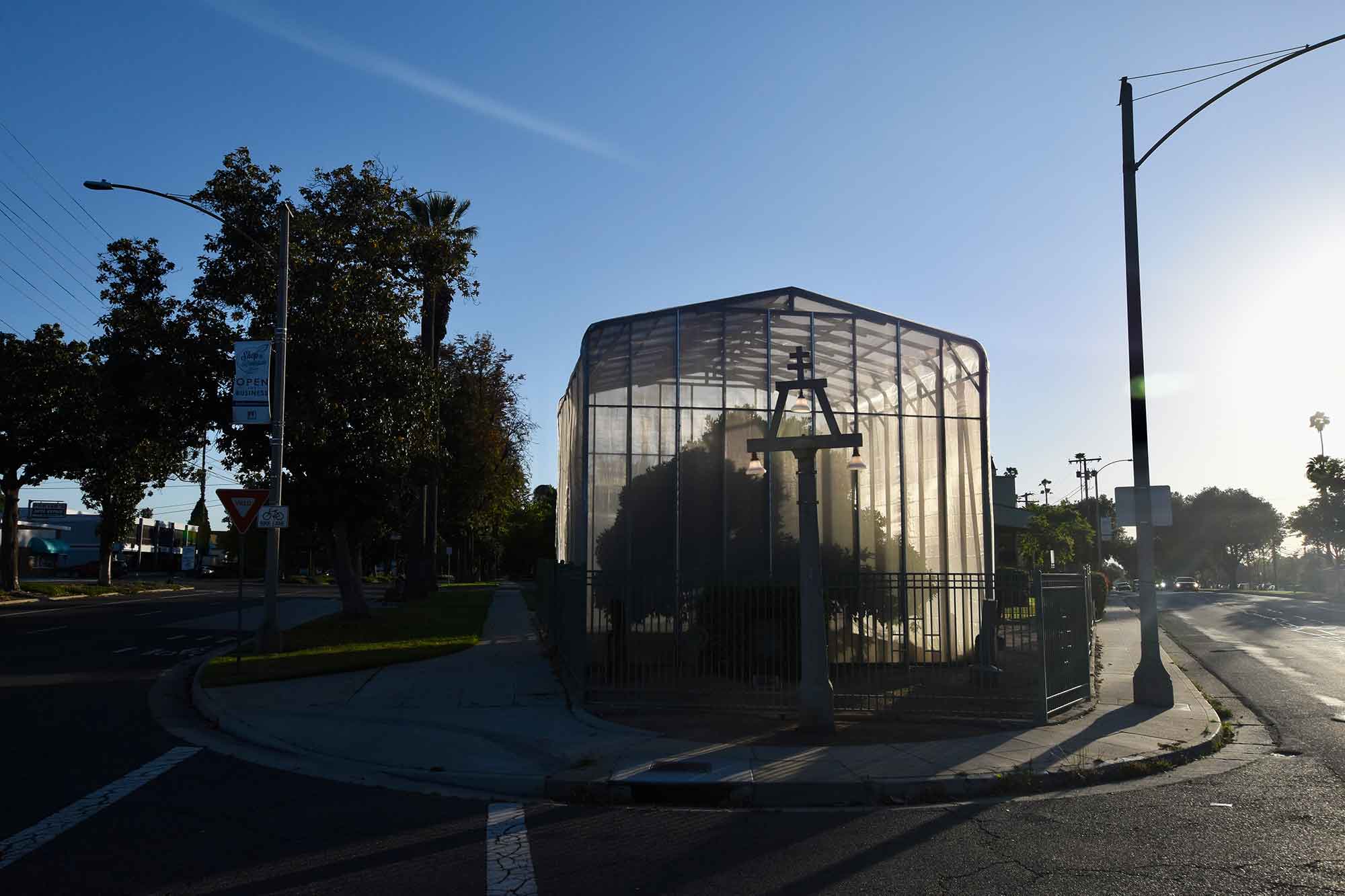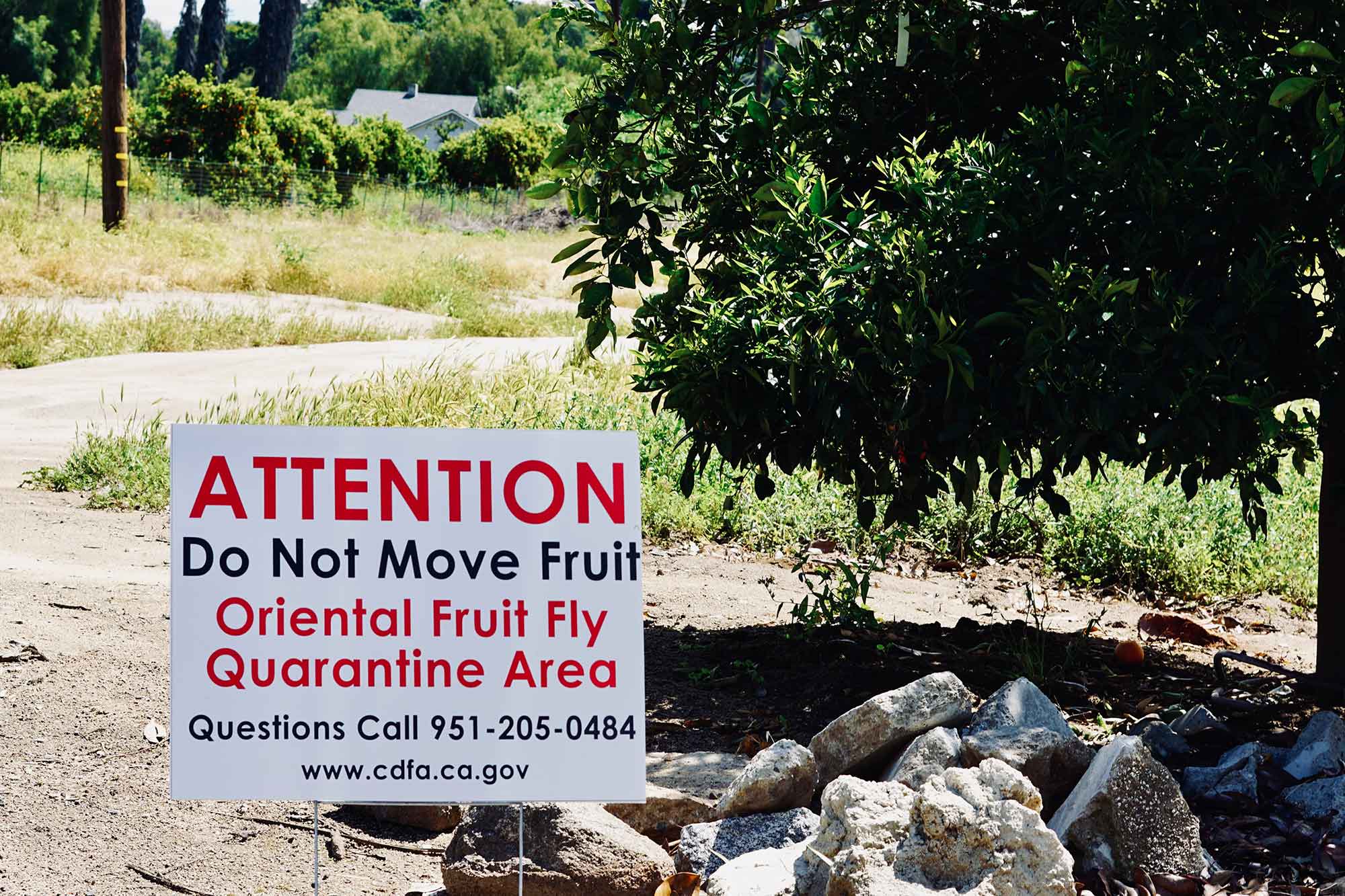Riverside’s most famous tree has a tent over it. The Mother Washington Navel at the corner of Arlington and Magnolia is the progenitor of the world’s multi-billion-dollar navel orange crop. Its great-great-great… grandchildren grow in groves from Riverside to Kern County, from South Africa to Australia, and from Brazil to India. And that tree is hard to miss nowadays as it is enclosed by a box of fine-mesh netting.
The netting prevents a tiny insect, the Asian Citrus Psyllid (ACP), from visiting the tree. That insect can carry the bacterium that causes the fatal Citrus disease known variously as “Citrus Greening,” “Huanglongbing,” and “HLB.” The tent was installed about seven years ago to protect the Mother Washington Navel after the first HLB-infected tree was found in Riverside, plunging the area into a disease quarantine by the California Department of Food and Agriculture (CDFA) that continues to this day.
Coincidentally, the netting also protects the tree from the Oriental Fruit Fly (OFF). The Oriental Fruit Fly is a house-fly-sized insect that lays its eggs on more than 400 species of crops, filling the innards of otherwise beautiful fruits with maggots. OFF appeared in the Riverside and Redlands area last fall and resulted in our second CDFA quarantine, which was associated with a threat to Riverside’s citrus trees (and many other fruit crops). In this case, the insect does not harm the tree, but the maggots spoil the fruit. The appearance of netting over fruits (including “vegetables” that are fruits such as tomatoes) in Riverside Farmer’s Markets since last fall is a consequence of the OFF. That netted produce is harvested outside of the quarantine; the point of the netting is NOT to prevent flies from escaping from the fruits on display but to keep local flies from infesting those fruits. Produce grown within the quarantine zone is prohibited from being sold.

The two quarantines are causing a lot of confusion. Let’s untangle this tale of two quarantines:
Huanglongbing (HLB)
The HLB quarantine zone covers parts of Riverside, San Diego, Ventura, Orange, Los Angeles, and San Bernardino Counties (CDFA - Citrus - Huanglongbing). The boundaries are defined by where HLB-infected trees have been located. At the moment, the major citrus-growing areas of California remain HLB-free.
HLB is a bacterial-cased disease specific to Citrus and some Citrus relatives. First discovered in China about a century ago, the fatal disease has ravaged Citrus crops in Asia, Africa, Brazil, and Florida. Florida has suffered so much that California has replaced it as the number one Citrus-producing state. The disease proceeds slowly through the tree, taking years to become symptomatic, but eventually resulting in leaf drop, misshaped and nasty-tasting fruit, and eventually death. On a visit to Florida, I learned that you could identify groves in advanced states of decline by the fact that such trees are so haggard that “you can throw a cat through them.” While harmless to humans, the disease is fatal to Citrus and has no known cure.
The bacterium can only be spread from an infected tree to an uninfected tree by ACP or by humans. The ACP is a tiny, sap-feeding insect, and it loves to feed on the small, fresh leaves of newly flushed branchlets. Native to China, ACP made its way to California via Mexico more than a decade ago. On the other hand, the bacterium likely came to California via smuggled infected trees from Asia planted into yards in Orange and Los Angeles County (remember, trees remain symptom-free for years.) Once the psyllid was present in California, it eventually began to spread the disease. Under California quarantine, a tree identified with HLB is immediately removed and destroyed. The vast number of HLB-diseased trees have been found and continue to be found in Orange County. Humans can disperse the HLB bacteria by moving infected trees or by grafting an infected bud or budwood onto a healthy tree. The chance of moving the disease organism via tools, such as unsterilized clippers, is very low but not zero.
Here's what you can’t do in an HLB quarantine area. The goal is to prevent uninfected trees from being infected. ACP likes to hang out on leaves, so you can’t move citrus trees, leaves, or leafy branches from one location to another within or outside the quarantine area. Likewise, because trees within a quarantine zone might appear to be healthy while in the early stages of infection, they cannot be used for budwood within or beyond the zone. Because ACPs avoid fruits, moving fruits (without any attached leaves) within or beyond the quarantine zone is OK in the context of HLB (however, see Oriental Fruit Fly below).
Is there good news? A decade ago, the future of HLB and the world’s citrus crop appeared grim at best. At that time, California’s citrus crop seemed doomed. But HLB has spread much more slowly in California than in Florida and Brazil. At present, the major citrus-producing areas of California remain HLB-free. Scientists at the University of California Riverside (UCR) and worldwide have put a lot of effort into HLP research. While no single silver bullet has yet emerged that promises to eradicate the disease, research suggests that some combination of approaches will result in an integrated solution for managing the disease. Here are some of the results of ongoing research that were presented in March at the 7th International Research Conference on Huanglongbing at the Riverside Convention Center by scientists from UCR and more than a dozen other countries: Antibiotics and other compounds appear to slow the progression of the disease in infected trees. Breeders are working to incorporate resistant genes from HLB-resistant Citrus relatives into vulnerable commercial varieties. Genetic engineers have moved anti-bacterial genes from other plants into commercial citrus cultivars. Entomologists have discovered parasitic wasps that can drastically reduce ACP populations. Microbiologists are manipulating the friendly bacteria of citrus to create disease-resistant microbiomes. It might still take a while, but someday, the HLB quarantine will be lifted.

Oriental Fruit Fly (OFF)
Presently, a large OFF quarantine zone occurs in parts of Riverside and San Bernardino Counties. The boundaries have been determined by where OFF have been identified. The vast majority of California agriculture remains OFF-free.
The OFF is a fly (that is, an insect with two wings) that superficially looks like a bee (which has four wings). It has a black and yellow thorax and a brown and yellow abdomen with a distinctive dark T-shape. Its larvae (fly larvae are known as “maggots”) can thrive inside hundreds of developing fruits, from citrus and most avocado types to stone fruits to walnuts to tomatoes. Imagine cutting into what appears to be a perfect navel orange, only to find it holds a ball of maggots! Thus, while not a danger to a plant, it renders fresh plant produce unfit for human consumption.
Oriental Fruit Fly is native to Southeast Asia but has established itself elsewhere in the tropics, including Africa, and various Pacific Islands, including Hawai’i. It is likely that Oriental Fruit Fly established in the Riverside area via a vacationer’s undeclared fruits that got dumped unceremoniously into a trash can or compost heap.
Here's what you can’t do in an OFF quarantine zone: The goal is to prevent living maggots from moving. So, you cannot move the fruit of any species in your yard or garden that is vulnerable to the fly. Specifically, you cannot share fresh fruit with friends, relatives, or neighbors either inside or outside of the quarantine zone. What you can do is process the fruits – juice, puree, eat, freeze, cook, preserve, dry, etc. There’s no problem sharing a processed product.
A lot of effort has been put into preventing OFF from getting a toehold in the Riverside-Redlands area. The Male Attraction Technique (MAT) has been deployed to attract and kill male adults. Specifically, chemical combinations of bait and control organic compounds are being strategically sprayed (see Spinosad Treatment for Exotic Fruit Fly Eradication). In the Redlands area, where most insects have been found, entire trees and groves have been stripped of their fruits, and the fruits have been destroyed.
While those efforts might seem draconian, the short-term future of OFF in SoCal is brighter than that of HLB. Various fruit flies have appeared in Southern California over the years. In each case, the infestation was caught early enough, and control efforts prevailed. Provided that no new fruit flies are detected over a time period equal to three OFF generations, the fly will be considered extirpated (for now), and the quarantine will be lifted sometime this summer. Fingers crossed!
In the end, the fate of agricultural quarantines depends on all of us. CDFA and other scientists are doing their part. For the rest of us, it’s important not to spread the problem. With respect to the HLB and OFF quarantines, moving specific plant materials and fruits within or between zones may increase the risk. With respect to preventing future quarantines, it's important to be mindful not to bring plant materials into California, not only from abroad but also from tropical agricultural areas within the United States, like Florida or Hawai’i. These quarantines are not the first for Southern California and not the last, but with good judgment, we can make sure that it is a long time before the next quarantine occurs!
This article benefited from information provided by Dr. Claire Federici, Staff Research Associate, Department of Botany and Plant Sciences, University of California, Riverside.





